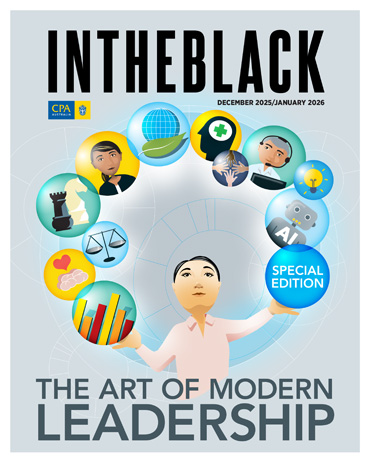Loading component...
At a glance
According to CPA Australia’s Business Technology Report 2024, profitable companies are doubling down on digital tools, outspending their less successful peers and embracing innovations like artificial intelligence (AI), data analytics and robotic process automation.
Thinking about investing but unsure where to begin? Here’s your road map.
How to choose core technology for a startup accounting firm

When putting together a small business tech stack, Peter Worn, joint managing director of wealth tech consultants Finura Group, says step one is to map out workflows in the practice.
“Work out what the client experience needs to look like and the jobs that need to be done within the practice to make client service as efficient as possible.
“Only choose the technology when that step is complete,” Worn says.
Most firms’ business technology has two pillars. The first is general productivity software, including the tools and apps to run the business, such as Microsoft 365 or Google Workspace.
“Ninety-nine per cent of businesses use Microsoft because of the capital and research and development Microsoft pours into its business enterprise technology. Small businesses benefit enormously from how much those technologies are improving and accelerating by using AI,” Worn says.
The second pillar is the specific accounting practice technology, such as Xero or MYOB for small practices.
Worn’s advice is to choose tech that staff are familiar with.
“That’s why people often go with Microsoft and Xero, because tens of thousands of people are familiar with them and you can have staff using the technology really quickly.”
Also, pick software that integrates easily with external plug-ins, such as work papers, document management and e-signing tools.
Practice-management tech
Core tech aside, Worn says accounting firms also need a practice management solution. Xero Practice Manager, FYI Docs or Microsoft SharePoint are popular client-portal and document-storage platforms.
“We think industry-specific tools like FYI Docs are a good way to go, because so much of accounting is about document management,” he adds.
When integrating accounting software with customer relationship management (CRM) in a business, the right CRM system depends on the size of the business.
“You may not need a CRM if you’re a two-person company in the suburbs, but larger firms and multidisciplinary practices that offer accounting and wealth management will typically have a CRM,” Worn says.
Payroll and HR software, as well as tools for automating compliance and digital signatures, are a must, although, some of this functionality is built into Xero.

Hani El-Rafei CPA, director of accounting tech solutions business Crunchlab, agrees that there are many benefits to using software that is widely accepted across the accounting profession.
“Most of our clients use Xero, which makes it easy because we use the one accounting system. We use Asana for task management and Google Workspace for emails, which includes Google Drive for file storage and Otter.AI for transcription,” El-Rafei says.
“We use Zapier to fill in the gaps between different tools that don’t speak to each other, for instance, to connect Google Forms to an email or Ignition — which we use for proposals — to our mailing list.”
Make the most of existing assets first
Maximising existing tech is essential, rather than constantly adding to it.
“We always say choose one, learn it deeply and maximise it to its full potential before you start adding new things,” Worn says.
However, there are some situations that call for specialist software. The Xero client portal, for example, is not considered user-friendly for people accessing the software on a phone.
Some accounting firms use myprosperity, because it is designed to be a collaboration tool between accountants and clients.
“But get the foundations right first,” Worn says.
It is also important to recognise the risks and rewards of being an early adopter, he advises.
“There are potential benefits if you have a team and culture that embraces innovation and constant improvement. You can impress clients by differentiating your business with technology, and being an early adopter can be an employment value proposition when recruiting great people into the business,” Worn says.
The risk of early adoption is making mistakes, and the firm’s culture needs to have the capacity to handle that. Similarly, the business has to be adept at embracing change when it comes to tech.
Any early adoption of technology needs to be accompanied by support resources.

“If you are not a technologist, you are probably going to struggle. But if you do understand systems — and I’m not saying you need to be a systems developer — you can get in at a good entry point and achieve things in your business other people have no chance of even getting to,” says Fiona Dixon, partner at professional services firm HLB Mann Judd.
There are also potential risks that come with working with relatively unknown software developers.
“If you make a big investment and then you need to make another big investment fairly soon, or [the developers] promise the world and it just never quite gets there, you’re stuck with workarounds,” Dixon says.
“It can be a game changer, but it really depends on where you are in the business and in its life cycle,” she says.
Recognise the importance of culture in implementation
While the choice of software is important, what is equally critical is the business’s culture.
“Even if an app or tech solution is feature-rich, it might not be the best one for a team. It’s important to find apps that integrate with how people work,” El-Rafei says.
He recounts a situation where Crunchlab implemented a suite of different apps for a client, which at first glance seemed to be working effectively. The practice manager was on board and the procedures had been documented, but it turned out the “team’s internal politics were not healthy”.
“You need buy-in,” El-Rafei says. “Leaders need to ensure that team members have done the training and spent time understanding how the apps work. You have to clearly communicate to the team — because people don’t like change.”
El-Rafei uses a framework called “problem, agitate, solution” to do this.
“Find out what the problems in the business are and how they impact the team. Then, provide the solution and, that way, it makes the team feel like they have been listened to and you’ve considered their pain points. This means the implementation is more likely to be successful,” he says.
Review the stack often
For more established firms, it’s key to regularly take stock of the technology the practice is using.
“If you have a lot of apps, it’s likely some of them are doing the same thing. But removing tech requires planning and management, because turning off apps could have serious consequences,” Dixon says.
“It comes down to people management — getting staff comfortable with changing the tech they are using to something that suits your needs more holistically.”
Especially given the rapid advancements in AI, technology is something that needs to be regularly reviewed. “Tech is not set-and-forget,” Dixon says.

